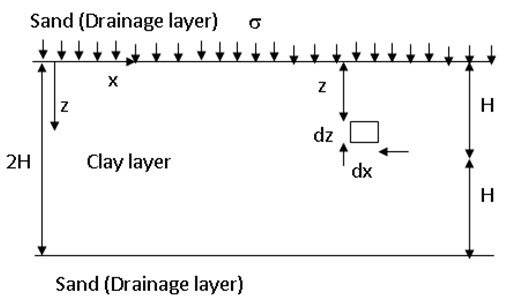Site pages
Current course
Participants
General
MODULE 1. Fundamentals of Soil Mechanics
MODULE 2. Stress and Strength
MODULE 3. Compaction, Seepage and Consolidation of...
MODULE 4. Earth pressure, Slope Stability and Soil...
Keywords
LESSON 22. One Dimensional Consolidation
22.1 Terzaghi’s Theory
By using the Terzaghi’s theory the rate of consolidation can be determined. The assumptions are:
-
The compression and flow are 1-D only (in the vertical direction only)
-
The soil is homogeneous
-
The soil is completely saturated
-
Dercy’s law is valid
-
Both water inside the pore and soil grains are incompressible
-
Strains are small
-
Void ratio decreases with the increase in applied stress. Hence change in void ratio, de = -av \[d\bar \sigma\] , where av is the coefficient of compressibility.
Figure 22.1 shows a clay layer in between two sand layers (drainage layers). Clay layer is subjected a uniformly distributed stress σ. A small soil element of dimension dx, dy and dz is chosen at a depth of ‘z’ from the top of the clay layer or consolidating layer. The continuity equation of the element can be written as:
\[\left( {{{\partial {v_x}} \over {\partial x}} + {{\partial {v_y}} \over {\partial y}} + {{\partial {v_z}} \over {\partial z}}} \right)dx\,dy\,dz={{\partial V} \over {\partial t}}\] (22.1)
where vx, vy and vz are the velocity in x, y and z direction, respectively. δV is the change in volume. For 1-D consolidation, Eq. (22.1) can be written as:

Fig. 22.1. 1-D consolidation.
\[\left( {{{\partial {v_z}} \over {\partial z}}} \right)dx\,dy\,dz={{\partial V} \over {\partial t}}\] (22.2)
Now according to Dercy’s law,
\[{v_z}={k_z}{{\partial h} \over {\partial z}}\] (22.3)
where kz is the coefficient of permeability, h is the head which causes flow during consolidation. The Eq. (22.3) can be written as:
\[{{\partial {v_z}} \over {\partial z}}={k_z}{{{\partial ^2}h} \over {\partial {z^2}}}\] (22.4)
The head h can be expressed as:
\[h={u \over {{\gamma _w}}}\] (22.5)
where ‘u’ is the excess pore water pressure and \[\gamma\]w is the unit weight of water. Combining Eq. (22.2) and Eq. (22.4), one can write
\[{{{k_z}} \over {{\gamma _w}}}{{{\partial ^2}u} \over {\partial {z^2}}}dx\,dy\,dz={{\partial V} \over {\partial t}}\] (22.6)
Now rate of change of volume can be written as:
\[{{\partial V} \over {\partial t}}={\partial\over {\partial t}}\left( {dx\,dy\,dz} \right)\] (22.7)
If volume of soil element V = dx dy dz and e0 is the initial void ratio, then the volume of voids (Vv) can be written as:
\[{V_v}={{{e_0}}\over {1 + {e_0}}}dx\,dy\,dz\] (22.8)
When Vv is to experience change, e will be a variable. Thus, Eq. (22.8) can be written as:
\[{V_v}={e \over {1 + {e_0}}}dx\,dy\,dz\] (22.9)
The change in volume is due to the change in volume of voids. Thus, combining Eq. (22.7) and Eq. (22.9) one can write
\[{{\partial V}\over{\partial t}}={\partial\over{\partial t}}\left({{e\over{1 + {e_0}}}dx\,dy\,dz}\right)\] (22.10)
Now, volume of solid soil (Vs) grains is a constant and can be expressed as:
\[{V_s}={1 \over {1 + {e_0}}}dx\,dy\,dz\] (22.11)
Thus, Eq. (22.10) can be written as:
\[{{\partial V}\over{\partial t}}={\partial\over{\partial t}}\left({{e\over{1 + {e_0}}}dx\,dy\,dz}\right)={{dx\,dy\,dz}\over{1 + {e_0}}}{{\partial e}\over {\partial t}}\] (22.12)
A time t =0, applied stress is equal to excess pore water pressure. Thus, du = -dσ , the negative sign means as the excess pore water pressure decreases effective stress increases. Again, de = -av \[d\bar \sigma\] . Thus, de = av du. Eq. (22.12) can be written as:
\[{{\partial V}\over{\partial t}}={{dx\,dy\,dz}\over{1+{e_0}}}{{\partial e}\over{\partial t}}={{dz\,dy\,dz}\over{1 + {e_0}}}{a_v}{{\partial u}\over {\partial t}}\] (22.13)
Combining Eq. 22.6) and Eq. (22.13), one can get
\[{{{k_z}}\over{{\gamma _w}}}{{{\partial ^2}u}\over{\partial{z^2}}}dx\,dy\,dz={{dz\,dy\,dz}\over {1 + {e_0}}}{a_v}{{\partial u}\over{\partial t}}\] (22.14)
Thus,
\[{{\partial u}\over{\partial t}}={{{k_z}}\over {{\gamma _w}}}{{1 + {e_0}}\over {{a_v}}}{{{\partial ^2}u}\over{\partial {z^2}}}\] (22.15)
\[{{\partial u} \over {\partial t}}={c_v}{{{\partial ^2}u} \over {\partial {z^2}}}\] (22.16)
where cv is the coefficient of consolidation and can be expressed as:
\[{c_v}={{{k_z}}\over{{\gamma _w}}}{{1 + {e_0}}\over {{a_v}}}={{{k_z}}\over{{\gamma _w}{m_v}}}\] (22.17)
where mv is the compressibility of soil and can be expressed as:
\[{m_v}={{{a_v}} \over {1 + {e_0}}}\] (22.18)
The boundary and initial conditions are:
At t = 0, u = ui and ui = σ
At t →
, u = 0 for all z
t >0, z = 0, u = 0
t >0, z = 2H, u = 0 (if drainage layer is present in top and bottom of the consolidating layer).
In Terzaghi’s solution, three non-dimensional factors are presented as:
Drainage depth ratio, \[Z={z \over H}\] (22.19)
Tine factor, \[{T_v}={{{c_v}t} \over {{H^2}}}\] (if drainage layer is present in top and bottom of the consolidating layer) (22.20)
Time factor, \[{T_v}={{{c_v}t} \over {{{\left( {2H} \right)}^2}}}\] (22.21)
Thus, \[t \propto {{{H^2}} \over {{c_v}}}\] (22.22)
Degree of consolidation, \[{U_z}={{{u_i} - {u_z}} \over {{u_i}}}=1-{{{u_z}} \over {{u_i}}}\] (22.23)
In Terzaghi’s solution, Uz is expressed in terms of Fourier series as:
\[{U_z}=1-\sum\limits_{n = 0}^ \propto{{f_1}(Z){f_2}({T_v})}\] (22.24)
-
At t = 0, Tv = 0 and Uz = 0 for all values of Z
-
At t →
 , Tv → µ and Uz = 1 or 100% for all values of Z
, Tv → µ and Uz = 1 or 100% for all values of Z
Thus, degree of consolidation is a function of Tv. For example, U = 50% if Tv = 0.197 and U = 90% if Tv = 0.848. Keeping soil parameters constant, as the time increases degree of consolidation also increases.
References
Ranjan, G. and Rao, A.S.R. (2000). Basic and Applied Soil Mechanics. New Age International Publisher, New Delhi, India.
Suggested Readings
Ranjan, G. and Rao, A.S.R. (2000) Basic and Applied Soil Mechanics. New Age International Publisher, New Delhi, India.
Arora, K.R. (2003) Soil Mechanics and Foundation Engineering. Standard Publishers Distributors, New Delhi, India.
Murthy V.N.S (1996) A Text Book of Soil Mechanics and Foundation Engineering, UBS Publishers’ Distributors Ltd. New Delhi, India.